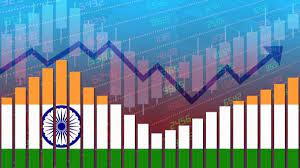NEW DELHI, Dec 31:India decisively withstood global headwinds in 2023 and is likely to remain as the world’s fastest-growing major economy on the back of growing demand, moderate inflation, stable interest rate regime and robust foreign exchange reserves.
Despite widespread pessimism witnessed among the developed nations and the worsening geopolitical situation, India recorded a gross domestic product (GDP) expansion of 6.1 per cent in the March quarter. The growth moved up to 7.8 per cent in the June quarter and was 7.6 per cent in the September quarter.
For the first six months of this fiscal, the growth was 7.7 per cent.
The growth momentum is expected to sustain in the December quarter, making India the fastest-growing major economy in the world much ahead of China.
According to the latest growth projections of the Organization for Economic Cooperation and Development (OECD), which appear conservative, India will record a growth of 6.3 per cent in 2023, ahead of China and Brazil at 5.2 per cent and 3 per cent, respectively.
For 2024, the OECD expects India to grow at 6.1 per cent and China at 4.7 per cent.
On the other hand, major economies, including the US, UK and Japan, are likely to witness either deceleration or very nominal increase in economic growth rates in the coming year.
India’s performance on the economic front in 2023 appears even better when viewed from a global perspective.
As per the International Monetary Fund’s (IMF) World Economic Outlook, global growth is estimated to decelerate from 3.5 per cent in 2022 to 3 per cent in 2023 and further to 2.9 per cent in 2024.
Ashima Goyal, Member of the Reserve Bank of India’s Monetary Policy Committee (MPC), said India’s growth has “shown great resilience despite many external shocks. This is due to increasing economic diversity and the role of policy in smoothing shocks”.
Equipping people with better skills and assets, she said, “will add up to give India good growth in 2024 and beyond”.
Dharmakirti Joshi, Chief Economist at rating agency Crisil, said geopolitical developments will again test the resilience of India’s domestic demand in the coming year.
“We expect the GDP to grow at 6.4 per cent in the coming fiscal year, a tad lower than the current one. The lagged impact of interest rate hikes and the global slowdown will be the key drags,” he noted.
A recent article on the state of the economy by the RBI said, “Despite significant global headwinds, the Indian economy remained the fastest growing major economy in 2023. The outlook is one of cautious optimism as consumer confidence remains positive and perceptions about current income turned up in the RBI’s latest survey of households in November 2023”.
RBI’s dynamic Stochastic General Equilibrium (DSGE) model — which is based on microeconomic foundations and rational expectations characterising the choices of agents, such as the representative consumer, producer and the central bank — projects a growth rate of 6 per cent in the financial year 2024-25.
“After a couple of difficult years, the economic environment is turning more benign with inflation trending down and growth remaining robust. Most forecasts project that growth in 2024-25 would be close to but slightly lower than in 2023-24. The global slowdown and geopolitical uncertainty remain the biggest risks to growth,” MPC Member Jayanth R Varma said.
Retail inflation is on a downward trajectory after touching a peak of 7.44 per cent in July. This year began with retail inflation of 6.52 per cent in January, and it softened to 4.31 per cent in May before rising to 7.44 per cent in July.
In November, the retail inflation worked out to be 5.55 per cent, which was within RBI’s comfort zone but some distance away from the mean rate of 4 per cent.
Aditi Nayar, Chief Economist at rating agency Icra, said inflation is likely to moderate, although a well-distributed monsoon will be crucial for quelling food inflation.
India’s macros appear to be in a good place heading into 2024. The growth is expected at 6.5 per cent in FY2024 and 6.2 per cent in FY2025, she added.
As per the central bank’s DSGE model, the retail inflation during the financial year 2024-25 is projected to decline to 4.8 per cent from 4.9 per cent estimated for the current fiscal.
Following the policy of remaining “actively disinflationary”, the RBI has kept the short-term interest rate or repo rate unchanged at 6.5 per cent since February.
RBI Governor Shaktikanta Das ended the rate hike cycle, which began in May 2022, by opting for the status quo in policy rate from April 2023. The stable interest rate regime has yielded good dividends and strengthened the twin balance sheets of banks and corporates.
It is likely that the Reserve Bank may go in for a rate cut during the course of 2024 if the retail inflation remains within the specified band of 2 to 6 per cent and the price of crude oil does not show any unexpected spike driven by geopolitical factors, including Russia-Ukraine war, Israel-Gaza conflict and blockade of Red Sea route.
“Overall, the forces are likely to balance out in calendar year 2024, giving us a comfortable growth rate in the range of 6.3 per cent to 6.6 per cent. The joker in the pack is geopolitics and conflict hotspots – the worsening or easing of the current conflicts will determine the landing bias of the growth rate to the lower or higher end, respectively,” opined Ranen Banerjee, Partner, Economic Advisory Services, PwC India.
The comforting factor for India in the midst of a worsening geopolitical climate and global economic slowdown is the foreign exchange reserves, which crossed the USD 600 billion mark in December after a gap of about four months.
Also on the external front, the current account deficit showed remarkable improvement, and it narrowed sharply to 1 per cent of GDP in the September 2023 quarter against 3.8 per cent in the year-ago period. (PTI)


